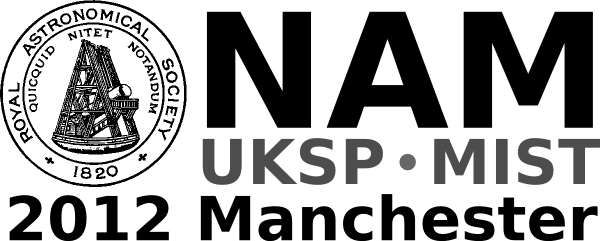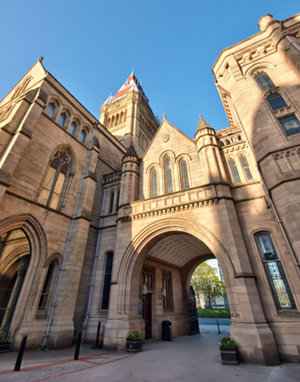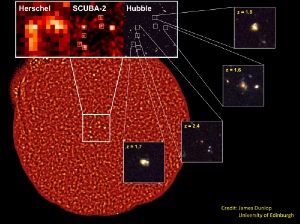UK-Germany National Astronomy Meeting NAM2012
New SCUBA-2 camera reveals wild youth of the universe
Royal Astronomical Society press release
RAS PR 12/14 (NAM 5)
Tuesday 27 March 2012
A team of astronomers from the UK, Canada and the Netherlands have commenced a revolutionary new study of cosmic star-formation history, looking back in time to when the universe was still in its lively and somewhat unruly youth! The consortium, co-led by University of Edinburgh astrophysicist Professor James Dunlop, is using a brand new camera called SCUBA-2, the most powerful camera ever developed for observing light at "sub-mm" wavelengths (light that has a wavelength 1000 times longer than we can see with our eyes). Prof. Dunlop will present the first results from the survey on Tuesday 27 March at the National Astronomy Meeting in Manchester.
SCUBA-2 is mounted on the world's largest sub-mm telescope, the 15-metre James Clerk Maxwell Telescope (JCMT), located atop the 4,300-metre high peak of Mauna Kea in Hawaii. The new project, named the SCUBA-2 Cosmology Legacy Survey will run for 3 years and will use the camera to provide the clearest view to date of dust-enshrouded star-forming galaxies. These objects are so remote that the light we detect left them billions of years ago, so we see them as they looked in the distant past. With SCUBA-2 astronomers are able to study objects that existed as far back as 13 billion years ago, within the first billion years after the Big Bang.
Because stars form inside clouds of gas and dust, much of the ultraviolet light from young galaxies is absorbed by this cosmic dust which is then heated to a few tens of degrees above absolute zero (-273 degrees Celsius). The "warmed" (but still rather "cool") dust then remits the absorbed energy at far-infrared wavelengths, which is then further redshifted to longer sub-mm wavelengths en-route to the Earth by the expansion of the Universe.
Detecting such emission is a challenge, both because Earth-based telescopes are warm and hence glow at sub-mm wavelengths and because water vapour in the atmosphere both absorbs and emits light in this waveband. To get around the problems of the atmosphere, the latest sub-mm surveys have recently been conducted from space, using the Herschel Space Observatory. However, the relatively small size (3.5-metre diameter) of Herschel means that the images it produces, while covering large areas, are rather fuzzy. Because its primary mirror is 20 times larger in area, the James Clerk Maxwell Telescope, now equipped with SCUBA-2, can provide a much sharper view of the sub-mm sky, especially on those occasions when the sky above the high mountain tops in Hawaii is really dry.
The SCUBA-2 Cosmology Legacy Survey is being targeted at areas on the sky which have already been studied in detail by other telescopes observing at different wavelengths. Of special importance is the Hubble Space Telescope (HST), which is undertaking a major 3-year survey (called CANDELS) of the visible light emission from high-redshift galaxies with its own new camera, Wide Field Camera 3 (WFC3). By combining the JCMT and HST imaging astronomers can gain an unparalleled view of the most massive galaxies which roamed the Universe back in the "golden era" of star formation activity.
The first image presented here is made using the SCUBA-2 camera at a wavelength of 450 microns. Zooming in, it shows seven distinct sub-mm sources that appeared blended together in the poorer-quality Herschel image. The Hubble images then show that the SCUBA-2 sources are massive, clumpy, violently star-forming disc galaxies, seen at a time when the Universe was about a quarter of its present age.
Prof. Dunlop is delighted by these first deep SCUBA-2 images and looking forward to more results over the next few years. "Edinburgh scientists and engineers worked hard to construct this revolutionary new instrument and, together with our colleagues in Canada and the Netherlands, we're now seeing the fruits of our efforts. With SCUBA-2 we can study the most violently star-forming galaxies in the young Universe, and slowly but surely start to understand how the primitive cosmos evolved into the universe we live in today."
IMAGES AND CAPTIONS
The SCUBA-2 image can be downloaded from http://www.roe.ac.uk/roe/support/pr/pressreleases/20120327-scuba2/scuba2-montage.png
Caption: The backdrop to the image shows the first deep sub-mm image made with SCUBA-2 at a wavelength of 450 microns. A zoom-in to the centre of this image shows seven distinct sub-mm sources, which were blended together in the poorer-quality Herschel image (shown on the left). These seven SCUBA-2 sources can then be matched to galaxies in the Hubble Space Telescope image (on the right). Further zoom-ins to the Hubble images of four of these galaxies are shown. These reveal that the SCUBA-2 sources are massive, clumpy, violently star-forming disc galaxies, seen at a time when the Universe was about a quarter of its present age. 'z' corresponds to the redshift of each galaxy and here indicates that we are seeing them as they were around 10 billion years ago. Credit: ROE / JCMT / SCUBA-2
Images of the James Clerk Maxwell Telescope can be downloaded from http://outreach.jach.hawaii.edu/photos/telescopepics.html
MEDIA CONTACTS
NAM 2012 Press Office (0900 - 1730 BST, 27-29 March; 0900 - 1630 BST 30 March)
Room 3.214
University Place building
University of Manchester
Manchester
UK
Tel: +44 (0)161 306 7313
Dr Robert Massey
Royal Astronomical Society
Mob: +44 (0)794 124 8035
Email: rm@ras.org.uk
Anita Heward
Royal Astronomical Society
Mob: +44 (0)7756 034 243
Email: anitaheward@btinternet.com
Dr Klaus Jaeger
Pressereferent / Press Officer im Vorstand der Astronomischen Gesellschaft
Tel: +49 6221 528 379
Email: pressereferent@astronomische-gesellschaft.de
Dan Cochlin
Media Officer (Faculty of Engineering and Physical Sciences)
University of Manchester
Tel: +44 (0)161 275 8387
Email: daniel.cochlin@manchester.ac.uk
Dr Holly Thomas
Joint Astronomy Centre
Hilo, Hawaii
Tel: +1 808 961 3756
Email: h.thomas@jach.hawaii.edu
SCIENCE CONTACTS
Prof James S. Dunlop (S2CLS co-PI)
Institute for Astronomy
University of Edinburgh
Royal Observatory
Edinburgh
UK
Tel: +44 (0)131 668 8477
Email: jsd@roe.ac.uk
Prof Ian Smail (S2CLS co-PI)
Institute for Computational Cosmology
Department of Physics
Durham University
South Road
Durham DH1 3LE
UK
Tel: +44 (0)191 334 3605
Email: ian.smail@durham.ac.uk
Prof Mark Halpern (S2CLS co-PI)
Department of Physics and Astronomy
6224 Agricultural Road
University of British Columbia
Vancouver
BC V6T-1Z1
Canada
Tel: +1 604 822 6709
Email: halpern@physics.ubc.ca
Prof Paul van der Werf (S2CLS co-PI)
Leiden Observatory
P.O. Box 9513
NL - 2300 RA
Leiden
The Netherlands
Tel: +31 71 527 5883
Email: pvdwerf@strw.leidenuniv.nl
Dr. Antonio Chrysostomou (Associate Director, JCMT)
Joint Astronomy Centre
660 N. A'ohoku Place
University Park
Hilo, Hawaii 96720
U.S.A.
Tel: +1 (808) 961 3756
Email: a.chrysostomou@jach.hawaii.edu
Prof Wayne Holland (SCUBA2 Project Scientist)
UK ATC
Royal Observatory
Edinburgh
UK
Tel: +44 (0)131 668 8389
Email: wayne.holland@stfc.ac.uk
NOTES FOR EDITORS
SCUBA-2 was designed and constructed at the Royal Observatory in Edinburgh at the UK Astronomy Technology Centre, before being shipped to the James Clerk Maxwell Telescope (JCMT) in Hawaii. For details of the JCMT, SCUBA-2 and the SCUBA-2 Cosmology Legacy Survey see the website of the Joint Astronomy Centre in Hawaii: http://www.jach.hawaii.edu/JCMT/
University of Edinburgh Institute for Astronomy http://www.roe.ac.uk/ifa/
For more details of the role of the UK ATC in SCUBA-2 see http://www.stfc.ac.uk/ukatc/35365.aspx
Hubble Space Telescope CANDELS Treasury Survey http://candels.ucolick.org/
Hubble Space Telescope (including Wide Field Camera 3) http://www.stsci.edu/
ESA: Herschel Space Observatory http://sci.esa.int/herschel/
NAM 2012
Bringing together more than 900 astronomers and space scientists, the National Astronomy Meeting (NAM 2012) will take place from 27-30 March 2012 in the University Place conference centre at the University of Manchester in the UK. The conference is a joint meeting of the Royal Astronomical Society (RAS) and the German Astronomische Gesellschaft (AG) and is held in conjunction with the UK Solar Physics (UKSP: www.uksolphys.org) and Magnetosphere Ionosphere Solar Terrestrial (MIST: www.mist.ac.uk) meetings. NAM 2012 is principally sponsored by the RAS, AG, STFC and the University of Manchester.
The Royal Astronomical Society
The Royal Astronomical Society (RAS: www.ras.org.uk), founded in 1820, encourages and promotes the study of astronomy, solar-system science, geophysics and closely related branches of science. The RAS organises scientific meetings, publishes international research and review journals, recognizes outstanding achievements by the award of medals and prizes, maintains an extensive library, supports education through grants and outreach activities and represents UK astronomy nationally and internationally. Its more than 3500 members (Fellows), a third based overseas, include scientific researchers in universities, observatories and laboratories as well as historians of astronomy and others.
The Astronomische Gesellschaft (AG)
The Astronomische Gesellschaft (AG: www.astronomische-gesellschaft.de), founded in 1863, is a modern astronomical society with more than 800 members dedicated to the advancement of astronomy and astrophysics and the networking between astronomers. It represents German astronomers, organises scientific meetings, publishes journals, offers grants, recognises outstanding work through awards and places a high priority on the support of talented young scientists, public outreach and astronomy education in schools.
The Science and Technology Facilities Council
The Science and Technology Facilities Council (STFC: www.stfc.ac.uk) is keeping the UK at the forefront of international science and tackling some of the most significant challenges facing society such as meeting our future energy needs, monitoring and understanding climate change, and global security. The Council has a broad science portfolio and works with the academic and industrial communities to share its expertise in materials science, space and ground-based astronomy technologies, laser science, microelectronics, wafer scale manufacturing, particle and nuclear physics, alternative energy production, radio communications and radar. It enables UK researchers to access leading international science facilities for example in the area of astronomy, the European Southern Observatory.
Jodrell Bank Centre for Astrophysics
The Jodrell Bank Centre for Astrophysics (JBCA: www.jb.man.ac.uk) is part of the School of Physics & Astronomy at the University of Manchester. JBCA is split over two main sites: the Alan Turing Building in Manchester and the Jodrell Bank Observatory in Cheshire. At Jodrell Bank Observatory, the new Jodrell Bank Discovery Centre is a key focus for our work in public engagement and education. Jodrell Bank is a world leader in radio astronomy-related research and technology development with a research programme extending across much of modern astrophysics. The group operates the e-MERLIN national radio astronomy facility and the iconic Lovell Telescope, hosts the UK ALMA Regional Centre Node and is home to the international office of the SKA Organisation. Funded by the University, the Science & Technology Facilities Council and the European Commission, it is one of the UK's largest astrophysics research groups.






